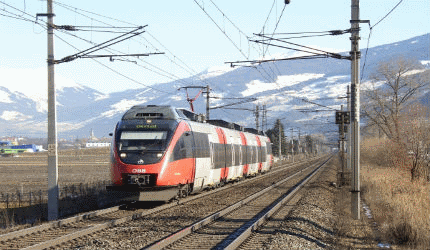
The first section of the 40km Lower Inn Valley Railway Line in Austria was inaugurated in November 2012, providing connection to the planned Brenner Base Tunnel.
The newly-constructed high-speed rail line connects Kundl and Baumkirchen, and forms part of the high capacity Trans-European Transportation (Ten-T) rail axis between Berlin and Palermo.
The Railway line, which involved an investment of €2.3bn ($3bn), is predominantly comprised of underground double tracks.
The Lower Inn Valley Railway Line is among the top 30 projects of the European Union (EU), which were marked as priority by the European Union (EU) both from economic and environmental perspectives. Construction work on the first section of the Railway line began in 2003, and was completed in November 2012.
Lower Inn Valley Railway Line background and purpose
The primary purpose of the new Lower Inn Valley Railway Line is to reduce the burden on the existing line. Nearly 330 trains operate on the route daily and the existing line, hence, became a bottleneck for the train traffic of North-South rail corridor travelling through Brenner.
The new Railway line will expand the capacity of the existing route, and will reduce the road traffic in the region.
It will thus help the EU in tackling the environmental issues of the Alpine zone. It is projected that the number of trains travelling on the Lower Inn Valley Railway Line will increase to 600 by the time of completion of the Brenner Base Tunnel.
The new Railway line will facilitate movement of both cargo and passengers, and is designed to enable trains to reach a top speed of 250kmph. The line will also reduce the journey time between Munich and Innsbruck by a minimum of about 50 minutes.
Construction of Austria’s Lower Inn Valley Railway Line
Work on the Lower Inn Valley Railway Line entailed construction of several tunnels, as about 32km of the 40km route passes through tunnels. In addition, the route includes several subsurface structures, such as U-boxes. A specialised mass-spring system was used for minimising the level of noise at Lower Inn Valley.
The new Railway line passes through Radfeld-Wiesing tunnel, Wiesing-Jenbach tunnel, Stans-Terfens tunnel and Terfens Gallery, and connects to the existing line at Baumkirchen.
Several tunnelling techniques, such as subaqueous open-cut works, compressed air and jet-piled supported open-face tunnel excavations, long drill and blast, and top-heading were used during construction of the Railway route. All tunnels of the route were designed to accommodate double tracks to enable simultaneous passage for trains approaching in both directions.
The Railway line construction involved approximately 142,000m of rail track, 71,000m of slab track and 35km of water supply lines. In addition, cabling work was done for a 1,130km stretch.
Signalling on the Lower Inn Valley Railway Line
The newly-built line is equipped with European Train Control System (ETCS) Level 2 Signalling System, along with four interlocking systems for both the new and current line. All systems are remotely controlled from the operations control centre at Innsbruck.
Contractors involved with Lower Inn Valley Railway Line
ÖBB Infrastruktur (the Austrian Federal Railways) appointed ARGE ALPTRANSIT ENERGIE, a joint venture between Rhomberg Bahntechnik and DB Bahnbau, as the general contractor for the Lower Inn Valley Railway Line project. ARGE handled the issues of design, planning and coordination.
Actes Bernard was awarded a contract for the design of the overhead line systems for the entire 40km stretch.
Funding the Lower Inn Valley Rail project
The EU provided funding of nearly €140m ($183.5m) for the Lower Inn Valley line construction from its TEN-T budget. The European Investment Bank (EIB) sanctioned €1bn ($1.3bn) for the project.
Related content
Salzburg Central Station Reconstruction, Austria
Salzburg Central Station, also known as Salzburg Hauptbahnhof, is owned and operated by Austrian Federal Railways (ÖBB Infrastruktur), and currently serves around 25,000 passengers in a day.
Brenner Base Rail Tunnel, Austria
The idea of the Brenner Base Tunnel (BBT) is to reduce the amount of heavy-load traffic on roads by shifting some to rail.




